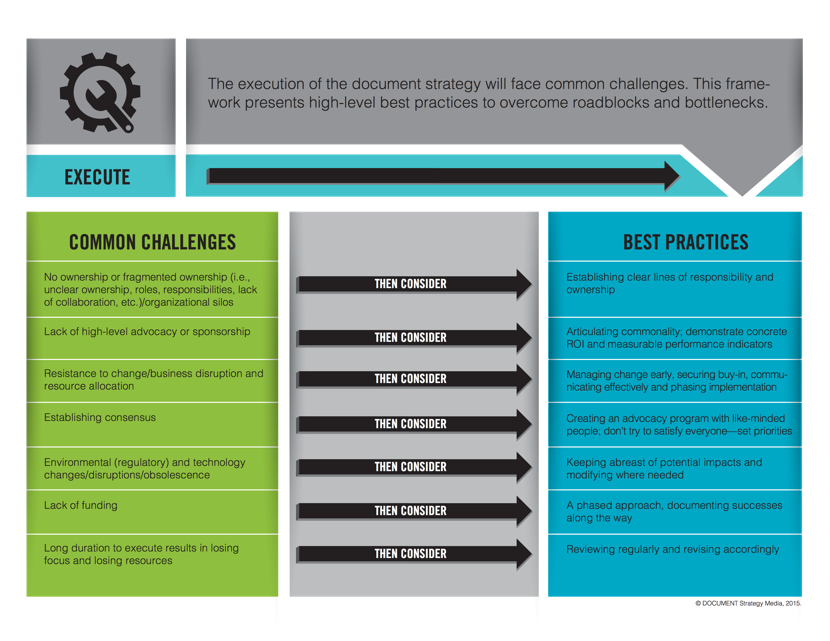
Build upon the four core strategy dimensions
We view strategic maturity as an optimized state, with cyclical, ongoing improvements and continual measurements and revisions as needed. Due to this, the framework positions the strategy dimensions and sub-dimensions along the content life cycle, as improvements will remain continuous. We define the four core dimensions of the strategy as (1) People, (2) Process, (3) Technology and (4) Governance. Within each of these core dimensions, we define the sub-dimensions aligned to specific life cycle stage in which most emphasis and priority should be given to stated sub-dimension. As you can see, sub-dimensions fall in more than one life cycle stage. Depending on the stage of maturity and duration of strategy, sub-dimensions will be prioritized differently. We recommend reviewing strategy dimensions and modifying accordingly along the phases of implementation.
The framework dimensions are all underlined by organizational alignment—the key to strategic execution and optimal performance. It is important to ask: Is your strategy aligned to the organizational vision and mission? Is it aligned to your people and technology? Furthermore, not enough emphasis can be placed on governance and defining ownership of the strategy. Without these controls and defined roles and responsibilities, your strategy will stall, undermined by confusion and unreliable metrics of progress.

Key challenges and best practices
As with any change, let alone one that is enterprise-wide, there are key barriers to successful execution and sustainable progress. Clearly understanding your organizational alignment, communicating a concrete return of investment (ROI), measuring quantitative performance indicators and regularly reviewing progress are best practices to overcome these challenges. We especially recommend the below best practices:
- Obtain high-level buy-in: Executive leadership support is driven by practical benefits and/or business priorities. Demonstrate concrete ROI with measurable performance indicators. If possible, create a demonstration or pilot program that shows how this strategy will positively impact the company.
- Create consensus: On the flip side, securing buy-in from all stakeholders impacted by the strategy is equally important as high-level sponsorship. Understand all individual business areas, communicate commonality and tightly connect departmental priorities to overall strategy. Use data, surveys and analytics to set priorities.
- Phase implementation and review regularly: Balancing expansive changes amidst normal business operations—as well as the effort required by your people—can be challenging. Phasing implementation can avoid a depletion of your resources, enable obtainable goals and provide concrete ROI for funding, if executive sponsorship is lacking. Additionally, it will promote regular reviews of the progress after each phase so modifications can be made accordingly.
Mark Blazek, USAA
Jackson Chin, Wells Fargo
Michael Coffman, Unum
Hope Correll, USAA
Michelle Debus, T. Rowe Price
Deanna Dorsey, Grange Insurance
Gerald Edwards, EmblemHealth
Nancy Green, MetLife
Claudia Guzman, USAA
Jessica Harman, Phillips 66
Christopher Kalna, The Carlyle Group
Fred Kam, UBS Financial Services Inc.
James Kennedy, Tallgrass Energy
Mike Kramer, USAA
Noam Lazarus, USAA
Lisa McQuade, USAA
DuPree W. Potter Sr., TIAA-CREF
David Schroeder, American Funds Service Company
Connie Schumacher, Purdue Pharma LP
Lynnette Sorensen, State Farm
April Speers, CUNA Mutual Group
Bob Traeger, Pershing
We’d like to thank Holly Muscolino, research vice president of document solutions at IDC, for her on-site facilitation of the working group at the DOCUMENT Strategy Forum and for her dedicated reviews of the framework. Our framework is truly a representation of the industry’s peer group and is a live document, which will be continually revised and updated. To download our framework, click here. For more information on the DOCUMENT Strategy Forum, visit www.documentstrategyforum.com.
Allison Lloyd serves as the editor of DOCUMENT Strategy Media. She delivers thought leadership on strategic and plan-based solutions for managing the entire document, communication and information process.















